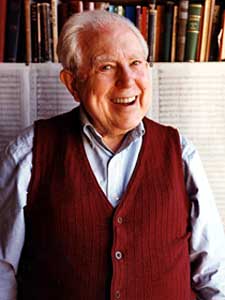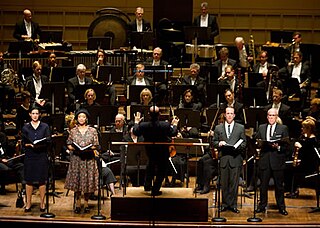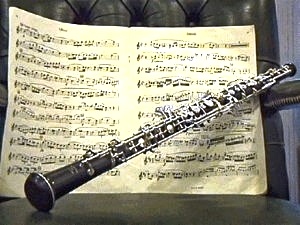Related Research Articles
A concerto is, from the late Baroque era, mostly understood as an instrumental composition, written for one or more soloists accompanied by an orchestra or other ensemble. The typical three-movement structure, a slow movement preceded and followed by fast movements, became a standard from the early 18th century.

The Pulitzer Prize for Music is one of seven Pulitzer Prizes awarded annually in Letters, Drama, and Music. It was first given in 1943. Joseph Pulitzer arranged for a music scholarship to be awarded each year, and this was eventually converted into a prize: "For a distinguished musical composition of significant dimension by an American that has had its first performance in the United States during the year."

A string orchestra is an orchestra consisting solely of a string section made up of the bowed strings used in Western Classical music. The instruments of such an orchestra are most often the following: the violin, which is divided into first and second violin players, the viola, the cello, and usually, but not always, the double bass.

Elliott Cook Carter Jr. was an American modernist composer. One of the most respected composers of the second half of the 20th century, he combined elements of European modernism and American "ultra-modernism" into a distinctive style with a personal harmonic and rhythmic language, after an early neoclassical phase. His compositions are performed throughout the world, and include orchestral, chamber music, solo instrumental, and vocal works. The recipient of many awards, Carter was twice awarded the Pulitzer Prize for his string quartets; he also wrote the large-scale orchestral triptych Symphonia: sum fluxae pretium spei.

Alan Hovhaness was an American composer of Armenian ancestry. He was one of the most prolific 20th-century composers, with his official catalog comprising 67 numbered symphonies and 434 opus numbers. The true tally is well over 500 surviving works, since many opus numbers comprise two or more distinct works.

Christian Lindberg is a Swedish trombonist, conductor and composer.

A clarinet concerto is a concerto for clarinet; that is, a musical composition for solo clarinet together with a large ensemble. Albert Rice has identified a work by Giuseppe Antonio Paganelli as possibly the earliest known concerto for solo clarinet; its score appears to be titled "Concerto per il Clareto" and may date from 1733. It may, however, be intended for soprano chalumeau. There are earlier concerti grossi with concertino clarinet parts including two by Johann Valentin Rathgeber, published in 1728.

Goffredo Petrassi was an Italian composer of modern classical music, conductor, and teacher. He is considered one of the most influential Italian composers of the twentieth century.

A viola concerto is a concerto contrasting a viola with another body of musical instruments such as an orchestra or chamber music ensemble. Throughout music history, especially during the Baroque, Classical, Romantic eras, viola was viewed mostly as an ensemble instrument. Though there were a few notable concertos written for the instrument in this time period, these instances were quite rare and the instrument continued to be ignored. However, during the 20th century, the instrument was revitalized thanks to the work of a number of violists and composers, which led to the commission and composition of many more viola concertos, expanding the repertoire significantly.

Steven Edward Stucky was a Pulitzer Prize-winning American composer.
The Group for Contemporary Music is an American chamber ensemble dedicated to the performance of contemporary classical music. It was founded in New York City in 1962 by Joel Krosnick, Harvey Sollberger and Charles Wuorinen and gave its first concert on October 22, 1962 in Columbia University's MacMillin Theatre. Krosnik left the ensemble in 1963. It was the first contemporary music ensemble based at a university and run by composers.
Adam Oscar Stern is an American conductor. Born in Hollywood, Los Angeles, California, United States, Stern was trained at the California Institute of the Arts in Los Angeles. He received his MFA in conducting in 1977 at the age of twenty-one, the youngest music student in CalArts' history to receive a master's degree.

A number of concertos have been written for the oboe, both as a solo instrument as well as in conjunction with other solo instrument(s), and accompanied by string orchestra, chamber orchestra, full orchestra, concert band, or similar large ensemble.
Olli Mustonen is a Finnish pianist, conductor, and composer.

The trumpet repertoire consists of solo literature and orchestral or, more commonly, band parts written for the trumpet. Tracings its origins to 1500 BC, the trumpet is a musical instrument with the highest register in the brass family.
A percussion concerto is a type of musical composition for a percussion soloist and a large ensemble, such as a concert band or orchestra. Two notable figures in the genre are the percussionists Colin Currie and Evelyn Glennie, who have separately commissioned and premiered numerous entrees to the repertoire. Two common subsets of the percussion concerto are the timpani concerto and the marimba concerto.
This page lists classical pieces in the trombone repertoire, including solo works, concertenti and chamber music of which trombone plays a significant part.
This page lists classical pieces in the tuba repertoire, including solo works, concertenti and chamber music of which tuba plays a significant part.
References
- ↑ Concerto for Orchestra, Paul Hindemith, Schott Music
- ↑ "Busch, Adolf", Hofmeisters Musikalisch-literarischer Monatsbericht, January 1931, p. 56
- ↑ Service, Tom (April 30, 2012). "A guide to Elliott Carter's music". The Guardian . Retrieved May 20, 2015.
- ↑ , Concerto for Orchestra, Richard Rodney Bennett, Wise Music Group
- ↑ Olmstead, Andrea (August 6, 2012). Roger Sessions: A Biography. Routledge. pp. 366–367. ISBN 1135868921.
- ↑ Kihss, Peter (May 11, 1982). "Sessions, Sylvia Plath and Updike Are Among Pulitzer Prize Winners". The New York Times . Retrieved May 11, 2015.
- ↑ Concerto for Orchestra, Stephen Paulus, Schott Music
- ↑ Webster, Daniel (September 21, 1988). "Reflecting The Image Of Muti Orchestra's Season Starts Tomorrow Night". The Philadelphia Inquirer . Retrieved January 21, 2016.
- ↑ Tower, Joan (1991). "Concerto for Orchestra". G. Schirmer, Inc. Retrieved January 21, 2016.
- ↑ Dobrin, Peter (April 14, 1999). "Phone Call Brings A Pulitzer, Credibility". The Philadelphia Inquirer . Retrieved January 21, 2016.
- ↑ Carter, Elliott (2002). "Boston Concerto". Boosey & Hawkes . Retrieved January 30, 2016.
- ↑ Farach-Colton, Andrew (April 2004). "Higdon Concerto for Orchestra; City Scape". Gramophone . Retrieved May 20, 2015.
- ↑ Child, Fred (April 5, 2005). "Steven Stucky Wins Pulitzer Prize for Music". NPR . Retrieved May 11, 2015.
- ↑ Kosman, Joshua (August 4, 2008). "Cabrillo composers morph the orchestra". San Francisco Chronicle . Retrieved May 11, 2015.
- ↑ Kozinn, Allan (April 27, 2012). "Every Instrument Has the Spotlight: The New York Philharmonic at Avery Fisher Hall". The New York Times . Retrieved June 17, 2015.
- ↑ , Concerto for Orchestra, George Benjamin.Faber Music
- ↑ Tommasini, Anthony (April 27, 2002). "Music Review; Catching Up With Elliott Carter". The New York Times . Retrieved February 22, 2016.
- ↑ Ung, Chinary. "Compositions Orchestra" . Retrieved February 18, 2023.